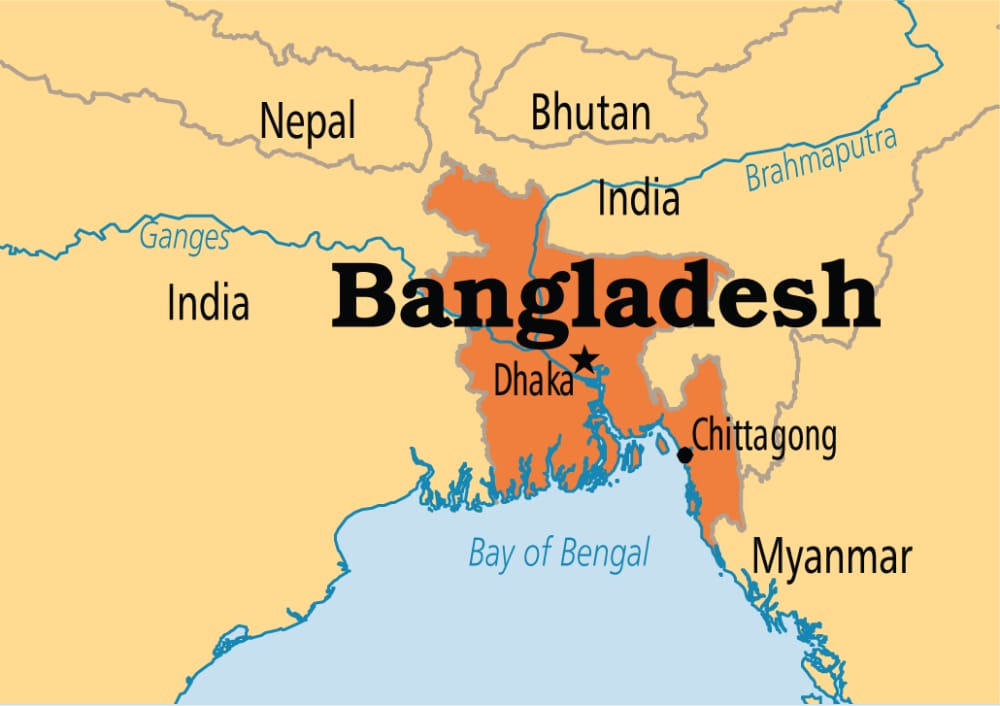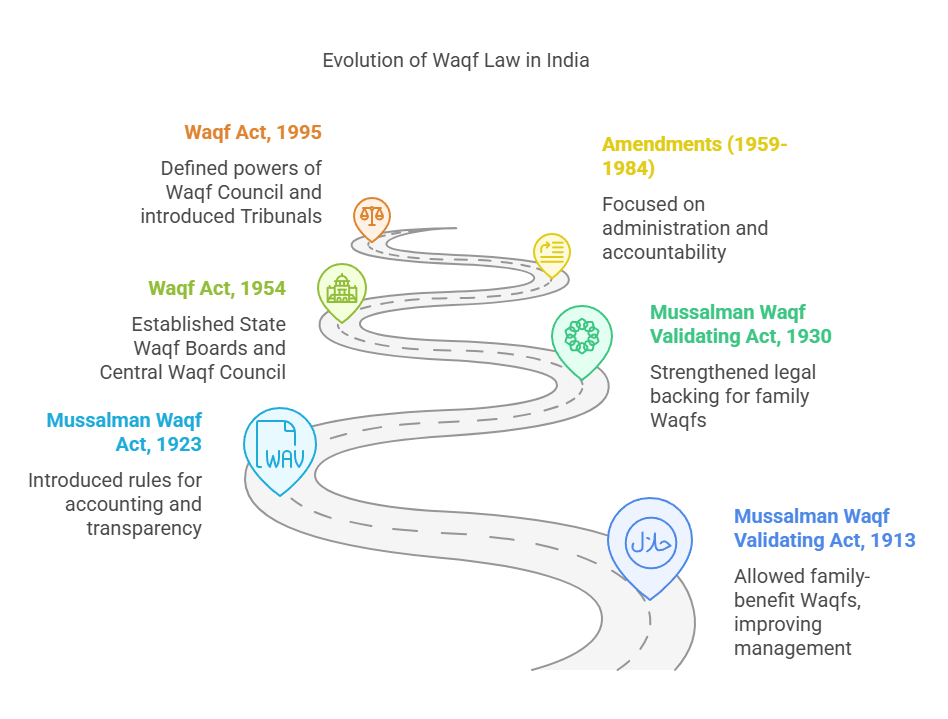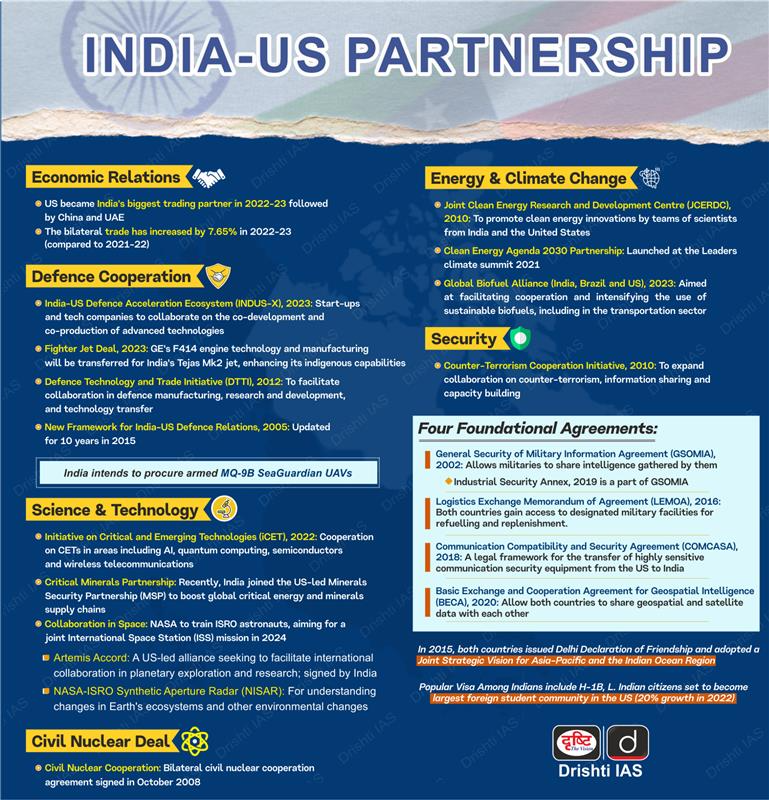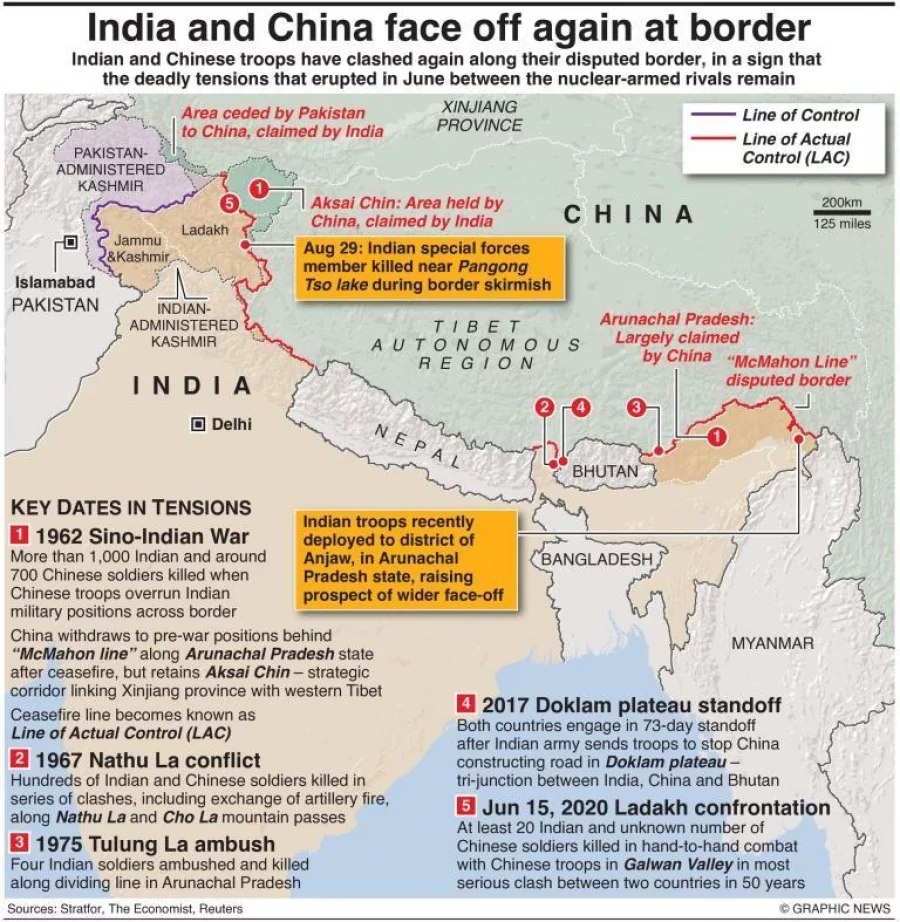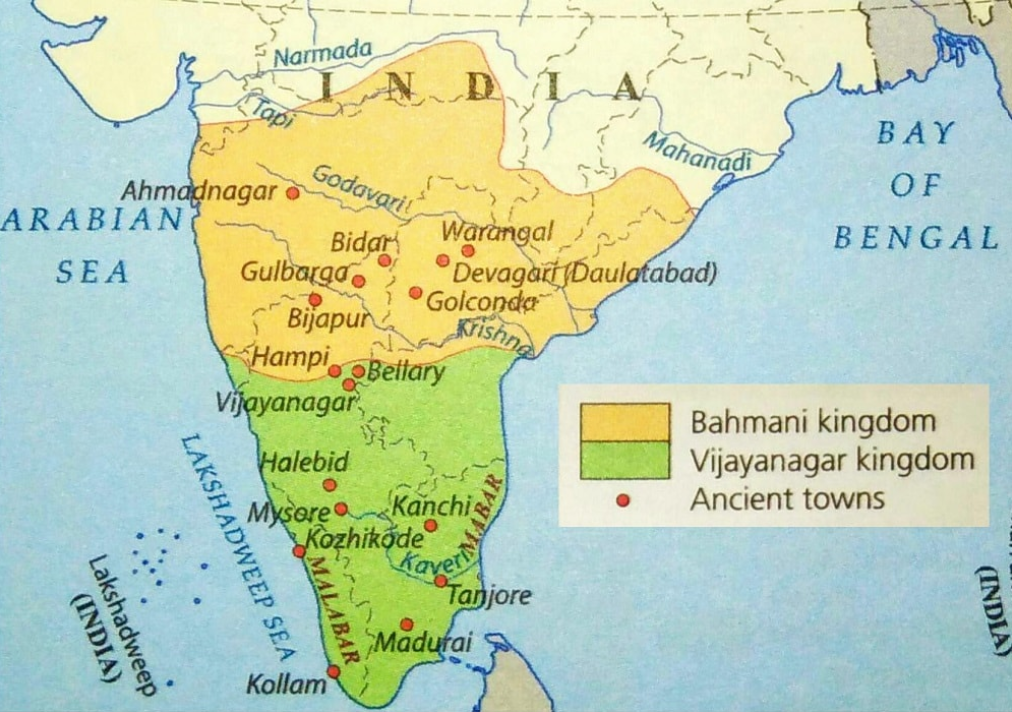International Relations
India-Bangladesh Relations
For Prelims: BIMSTEC, Exercise Bongosagar, India-Bangladesh Friendship Pipeline, Maitree Super Thermal Power Project, Smart fencing
For Mains: India’s Neighbourhood First Policy, India-Bangladesh bilateral relations, India’s Act East Policy.
Why in News?
Prime Minister Narendra Modi met with Bangladesh’s Chief Adviser Muhammad Yunus in Bangkok on the sidelines of the BIMSTEC (Bay of Bengal Multi-Sectoral Technical and Economic Cooperation) Summit, this marks their first official interaction since the ouster of former Prime Minister Sheikh Hasina.
What are the Key Highlights of India-Bangladesh Relations?
- Defence Cooperation: Both nations conduct joint military exercises such as Exercise Sampriti (Army) and Exercise Bongosagar (Navy), Coordinated Patrol (Navy) to enhance defence cooperation.
- Economic and Commercial: Bangladesh is India’s largest trade partner in South Asia, while India is its second-largest trade partner in Asia. In FY 2023-24, the total bilateral trade stood at USD 12.9 billion.
- India’s exports to Bangladesh stood at USD 11.06 billion and India’s imports from Bangladesh were at USD 1.8 billion.
- India’s key exports to Bangladesh include cotton, petroleum products, engineering goods, and chemicals.
- Major imports from Bangladesh are apparel, textiles, jute goods, and aerospace parts.
- Energy and Connectivity: The India-Bangladesh Friendship Pipeline is the first cross border energy pipeline between India and Bangladesh with a capacity to transport 1 Million Metric Ton Per Annum (MMTPA) of High-Speed Diesel (HSD) to Bangladesh, boosting energy ties.
- Key cross-border projects like the Akhaura-Agartala rail link, the Khulna-Mongla port rail line and Maitri Setu further strengthen connectivity and cooperation.
- The Maitree Super Thermal Power Project, developed by Bangladesh India Friendship Power Company (BIFPCL), a joint venture between National Thermal Power Corporation and Bangladesh Power Development Board, has been made operational and is supplying power to the Bangladesh grid.
- Multilateral Cooperation: India and Bangladesh actively collaborate in regional forums like South Asian Association for Regional Cooperation, BIMSTEC, and Indian Ocean Rim Association to strengthen economic and strategic ties.
What is the Significance of Bangladesh for India?Click here to Read: Significance of Bangladesh for India |
What are the Challenges in India-Bangladesh Relations?
- Diplomatic Disconnect: India’s close association with Sheikh Hasina alienated other political actors in Bangladesh.
- Post-Hasina, India lacks deep institutional links with the interim government and broader political spectrum.
- India's decision to host Sheikh Hasina in exile has been perceived in Bangladesh as political interference, further exacerbating tensions.
- Growing Chinese Influence: Bangladesh is a key partner in China’s Belt and Road Initiative (BRI) and receives significant Chinese investments in infrastructure projects such as ports, roads, energy, telecom, and the Teesta River Restoration.
- This growing presence adds a geopolitical dimension to India-Bangladesh bilateral tensions.
- Border Management & Illegal Migration: Illegal immigration from Bangladesh continues to strain India’s northeastern states, causing socio-economic and political tensions. The Rohingya refugee crisis has further complicated the issue.
- Persistent issues of cross-border terrorism, insurgency support, and trafficking remain with Insurgent groups like United Liberation Front of Asom have reportedly operated camps in Border regions.
- Rise of Anti-India Sentiment: Despite economic ties, public perception has soured due to perceived Indian interference in Bangladesh’s internal politics.
- Public protests, slogans like 'Delhi or Dhaka: Dhaka, Dhaka,' and campaigns such as 'India Out' reflect deep-rooted mistrust.
What Can Be Done to Enhance India-Bangladesh Relations?
- Engage Inclusively: Establish structured, long-term engagement with a broad spectrum by promoting track-2 diplomacy through think tanks, retired diplomats, and academic institutions.
- Institutionalise sub-national engagement by forming a "Bangladesh Engagement Forum" with Chief Ministers of bordering states (West Bengal, Assam, Tripura). Use platforms like North Eastern Council and Act East Forum to align regional connectivity with Bangladesh’s growth.
- Leverage Multilateral Initiatives: Integrate Bangladesh within India’s Indo-Pacific Oceans Initiative (IPOI) for regional maritime cooperation and accelerate the Bangladesh-Bhutan-India-Nepal Initiative Motor Vehicles Agreement to boost regional connectivity, facilitate smoother cross-border transportation, and enhance trade and economic integration.
- Border Management: Complete smart fencing of the India-Bangladesh border (under the Comprehensive Integrated Border Management System (CIBMS)) with priority to drug trafficking and cattle smuggling hotspots.
- People-to-People Connectivity: Create a Bangladesh Cultural Corridor under the Ministry of Culture to promote Indian cinema, classical arts, and academic translations into Bengali.
- Roll out scholarships like the 'Suborno Jayanti Scholarship (SJS)' for Bangladeshi youth in Indian universities and technical institutes.
|
Drishti Mains Question: Briefly discuss key challenges in India-Bangladesh ties and suggest ways to resolve them. |
UPSC Civil Services Examination, Previous Year Question (PYQ)
Q. With reference to river Teesta, consider the following statements: (2017)
- The source of river Teesta is the same as that of Brahmaputra but it flows through Sikkim.
- River Rangeet originates in Sikkim and it is a tributary of river Teesta.
- River Teesta flows into Bay of Bengal on the border of India and Bangladesh.
Which of the statements given above is/are correct?
(a) 1 and 3 only
(b) 2 only
(c) 2 and 3 only
(d) 1, 2 and 3
Ans: (b)
Mains
Q. Analyze internal security threats and transborder crimes along Myanmar, Bangladesh and Pakistan borders including Line of Control (LoC). Also discuss the role played by various security forces in this regard. (2018)


Indian Polity
Waqf (Amendment) Act, 2025
For Prelims: Waqf (Amendment) Act, 2025 Parliament, Waqf Act,1995, Mutawallis, Limitation Act, 1963, Rights to Equality (Article 14), Article 26.
For Mains: The Waqf (Amendment) Act, 2025 and related concerns.
Why in News?
The Waqf (Amendment) Act, 2025 was passed by the Parliament and it has received assent of the President.
- The Act amends the Waqf Act, 1995, allowing the government to regulate Waqf properties and settle related disputes.
- The Act aims to improve Waqf board efficiency, update Waqf definitions, streamline registration, and boost use of technology in record management.
What is Waqf?
What is Waqf Board and Waqf Act, 1995?
|
Note: There are 8.72 lakh waqf properties, covering an area of more than 38 lakh acres.
Evolution of Waqf Law in India
What are the Key Provisions of the 2025 Act ?
- Separation of Trusts from Waqf: Muslim-created trusts under any law will no longer be considered Waqf, ensuring individuals retain full control over their trusts.
- Eligibility for Waqf Dedication: Only practicing Muslims (for at least five years) can dedicate their property to Waqf.
- Properties already registered with Waqf Boards will remain so unless disputed or identified as government land.
- Women's Rights in Family Waqf: Women must receive their inheritance before Waqf dedication, with special provisions for widows, divorced women, and orphans.
- Ending Arbitrary Property Claims: Section 40 of the original Waqf Act (1995) has been removed, preventing Waqf Boards from arbitrarily declaring properties as Waqf.
- Section 40 of the Waqf Act (1995) gives the Waqf Board the authority to decide whether a property is a Waqf property or not.
- Waqf Tribunals: The Waqf tribunals consist of 3 members i.e., a district judge, a state government officer (joint secretary level), and an expert in Muslim law and jurisprudence.
- Aggrieved parties can appeal directly to the concerned High Court within 90 days of receiving the Waqf tribunal’s order.
- Government Land & Waqf disputes: An officer above the rank of Collector will investigate government properties claimed as Waqf to prevent any unwarranted claims.
- Reduced Annual Contributions: Waqf institutions' mandatory contribution to Waqf Boards reduced from 7% to 5% allowing more funds to be allocated for charitable purposes.
- Annual Audit Reforms: Waqf institutions earning over Rs 1 lakh must undergo audits by State-appointed auditors.
- Technology & Central Portal: A centralized portal will automate Waqf property management, improving efficiency and transparency.
- Mutawallis (caretaker of a waqf) must register property details on the central portal.
- Diverse Representation: The Waqf Boards will include two non-Muslim members for inclusivity, and among Muslim members, at least two must be women.
- Representation from Shia, Sunni, Bohra, Aghakhani, and OBC Muslim communities is also mandated.
- Application of the Limitation Act: The Limitation Act, 1963, will now apply to Waqf property claims, reducing prolonged litigation.
- The Limitation Act, sets time limits for filing cases to ensure speedy disposal and prevent delays in legal proceedings.
What was the Need of Waqf (Amendment) Act, 2025?
- Irrevocability of Waqf Properties: The principle "once a Waqf, always a Waqf" ensures Waqf properties remain permanent, often causing complex disputes.
- E.g., It has sparked controversies, like ownership claims over islands in Bet Dwarka, where courts face legal challenges in determining ownership.
- Poor Management: The Waqf Act, 1995 has failed to prevent mismanagement and land encroachments.
- E.g., In Karnataka (between 1975 and 2020), 40 Waqf properties were notified, including farmlands, public spaces, government lands, graveyards, lakes, and temples.
- Lack of Judicial Oversight: Under the Waqf Act, 1995, Waqf Tribunal decisions cannot be appealed, which limits judicial review and reduces transparency.
- Misuse of Powers: Section 40 of the Waqf Act, 1995 has been used to declare private properties as Waqf, leading to legal battles.
- E.g., In Kerala, around 600 Christian families protested after the Waqf Board claimed their ancestral lands leading to legal disputes.
What Concerns are Related to the Waqf (Amendment) Act, 2025?
- Increased Government Control: Critics argue that the Act grants the government the authority to regulate Waqf properties and determine their status, thereby reducing the autonomy of Waqf Boards.
- The deletion of Section 40 of the Act, shifts the power to determine whether a property is Waqf to government officials.
- Dilution of Muslim Representation: Critics argue that allowing non-Muslim officials on Waqf Boards violates the community’s right to manage its religious affairs under Article 26.
- Ambiguity in Defining a “Practising Muslim”: The Act lacks a clear definition of "practising Muslims" for Waqf property allocation, which may lead to legal challenges due to varied interpretations by religious scholars.
- Removal of "Waqf by User" Principle: Critics fear that removing "Waqf by user," which recognizes properties through long-term religious use, may lead to many existing sites losing their Waqf status.
Conclusion
The 2025 Act aims to enhance transparency, prevent misuse, and streamline dispute resolution through legal and technological reforms. However, concerns over government control, representation, and property rights must be addressed through dialogue to balance regulatory oversight with community autonomy. The rules for the Waqf (Amendment) Act, 2025 are yet to be released and are expected to address ambiguity and other concerns.
|
Drishti Mains Question: How does Waqf (Amendment) Act, 2025 seek to reform Waqf governance, and what concerns have been raised regarding its provisions? |
UPSC Civil Services Examination, Previous Year Questions (PYQs)
Mains
Q. How is the Indian concept of secularism different from the western model of secularism? Discuss. (2018)

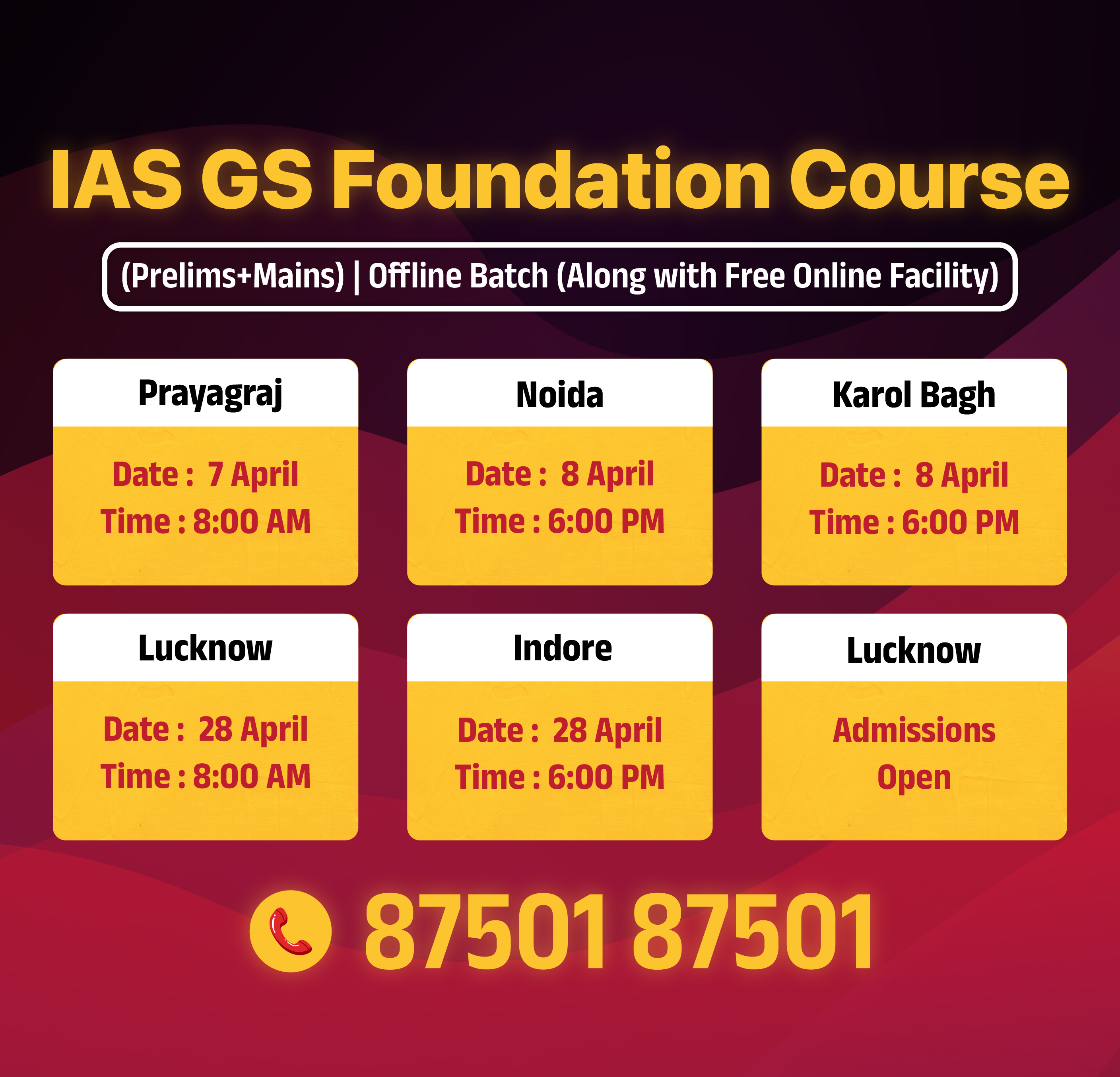
Ethics
Compassion in Primary Health Care
For Prelims: World Health Organization, Health and Wellness Centres, Ayushman Bharat, Tele MANAS
For Mains: Role of Compassion and Ethics in Public Service Delivery, Primary Health Care Reforms in India
Why in News?
The World Health Organization (WHO) released a report titled “Compassion and primary health care(PHC)” which highlights compassion as key to improving PHC and addressing rising mental health challenges through patient-centered and dignified care.
What is the Significance of Compassion in PHC?
- About: Compassion in PHC is the recognition of human suffering coupled with the motivation and action to alleviate it within the context of essential health services.
- It is not just a moral value but a practical driver that enhances the quality, accessibility, and equity of care.
- Significance: Compassion differs from sympathy and empathy. Sympathy is passive and pity-driven, while empathy can cause emotional fatigue.
- In contrast, compassion combines emotional connection with thoughtful action, making it a more sustainable and effective approach in health care.
- Role in Healthcare: The lifetime prevalence of mental disorders in India is 13.7%, and 15% of India's adult population experiences mental health issues.
- WHO estimates that the burden of mental health problems in India is 2443 disability-adjusted life years (DALYs) per 10000 population. The economic loss due to mental health conditions, between 2012-2030, is estimated at USD 1.03 trillion.
- In India 70% to 92% of people with mental disorders do not receive proper treatment due to lack of awareness, stigma, and shortage of professionals.
- With rising cases of depression and anxiety, compassion has become a vital component in healthcare. It promotes people-centred care by making services more responsive, respectful, and holistic.
- Moreover, compassion strengthens the entire health continuum spanning prevention, health promotion, treatment, rehabilitation, and palliative care, ensuring that care delivery is both effective and empathetic.
- Compassion fosters inclusive care, especially for Dalits, Adivasis, LGBTQ+ individuals, persons with disabilities, and other marginalised groups.
Case Studies Related to Compassionate Healthcare
- ASHA Worker Responding to Domestic Violence:
- Key Actor: ASHA worker Praveena Ben
- Ethical Lens: ASHA workers extended her roles beyond maternal health to address domestic violence, a deeply sensitive and stigmatized issue.
- She upheld the dignity and autonomy of survivors by ensuring private referrals and trauma-informed care.
- Tamil Nadu’s Disaster-Ready PHCs:
- Ethical Lens: Tamil Nadu’s health system showcases anticipatory ethical governance by training PHC staff for disaster response.
- Its interdepartmental coordination ensures swift, humane action during crises, while prioritizing ethical resource allocation to protect the most vulnerable.
- Ethical Lens: Tamil Nadu’s health system showcases anticipatory ethical governance by training PHC staff for disaster response.
- Clinical Courage in Tribal Areas:
- Key Actor: Dr. Vidith Panchal, Amrit Clinic (NGO: Basic Health Services).
- Ethical Lens: Despite poor infrastructure and limited support, Dr. Panchal chose to treat a critically ill TB patient, Tukaram, locally instead of referring him to a distant hospital prioritizing the patient’s dignity and comfort over administrative convenience.
- Acted with beneficence and compassion, providing comfort and reducing suffering in end-of-life care.
What Can Be Done to Enhance Compassionate Healthcare in India?
- Institutionalise Compassion: The National Health Policy, 2017 emphasizes the need for people-centred and ethical provisioning of healthcare.
- To strengthen this approach, compassion should be integrated as a measurable dimension of Quality of Care (QoC), alongside efficiency and effectiveness.
- Mandate Compassion Checklists in Health and Wellness Centres (HWCs) under Ayushman Bharat to improve patient-provider interaction.
- Enhance capacity of HWCs: Training health workers in trauma-informed and culturally sensitive care.
- Train Accredited Social Health Activists and Auxiliary Nurse Midwives in compassionate communication, especially while addressing domestic violence, abuse, adolescent health and mental distress
- Integrate Compassion Metrics in Audits: The 15th Finance Commission recommended outcome-based health grants, aligning with this, compassion scores from patient feedback systems can be integrated into outcomes.
- This approach ensures that healthcare providers are incentivized for compassionate healthcare
- NITI Aayog's Vision 2035 emphasizes people-first data systems, ensuring ethical data collection and respectful community engagement.
- Reform Curriculum: Introduce modules on compassionate leadership, grief counselling, and end-of-life communication.
- Mental Health Interventions: Tele MANAS, now operational in 20+ languages and having responded to 1.8 million calls, should embed empathy training modules for first-level responders.
- Adopt strategies that promote home visits, maternal counselling, and community health dialogue.
|
Drishti Mains Question: Discuss the importance of compassion as a measurable dimension in Primary Health Care. How can India institutionalise compassion in its healthcare delivery systems? |
UPSC Civil Services Examination, Previous Year Questions (PYQs)
Mains
Q. In order to enhance the prospects of social development, sound and adequate health care policies are needed particularly in the fields of geriatric and maternal health care.Discuss. (2020)


Facts for UPSC Mains
Concerns of Gorkha Community
Why in News?
The Ministry of Home Affairs (MHA) convened a meeting in New Delhi with key representatives of the Gorkha community, aimed at addressing their long-pending concerns.
Who are the Gorkhas?
- About: The Gorkhas (also spelled Gurkhas) are a martial community originating from Nepal, known for their bravery, loyalty, and fierce fighting skills.
- The Gorkhas trace their name from the Gorkha Kingdom in western Nepal. Prithvi Narayan Shah (1743–75), a Gorkha king, unified Nepal and expanded the Gorkha power.
- Ethnicity: Gorkhas are not a single ethnic group but include several ethnicities like Gurungs, Magars, Rais, Limbus, and others from the hilly regions of Nepal.
- Gorkha Regiments: Their reputation as fierce warriors led them to serve in various armies especially the British, Indian, and Nepalese armies.
- After the Anglo-Nepal War (1814-1816), also known as the Gorkha War, the British recruited them Gorkha into the British Army.
- The Gorkha regiment has been part of the Indian Army since 1815, following the Anglo-Nepal War.
What are the Concerns of Gorkhas?
- Demand for Gorkhaland: The demand for a separate state of Gorkhaland encompassing Darjeeling, Terai, and Dooars has been at the core of Gorkha identity politics since the 1980s.
- Gorkha leaders believe that statehood would provide political recognition, cultural autonomy, and administrative empowerment.
- Gorkhas seek constitutional and cultural recognition within India, including protection of their language, customs, and distinct ethnic identity.
- Scheduled Tribe (ST) Status: Several Gorkha communities such as Rai, Limbu, Gurung, Tamang, and others have been demanding ST status for decades.
- This recognition would enable social justice, educational opportunities, and affirmative action benefits.
- Despite repeated assurances by the Centre, the process has seen no meaningful progress.
- Agnipath scheme: India’s Agnipath scheme, which offers only four years of service with no pension unless retained, raising fears of job insecurity among Nepali Gorkhas.
- Nepal views this as a violation of the 1947 tripartite agreement that ensured permanent service and pension benefits.
- Geopolitical Tensions: Additionally, geopolitical tensions have emerged, with reports (like Observer Research Foundation) suggesting China’s interest in recruiting Gorkhas. Diplomatic resolution remains pending, with hopes resting on high-level talks between India and Nepal.
| Read more: 1947 Tripartite Agreement on Gurkha soldiers |
|
Drishti Mains Question: Analyze the historical and cultural evolution of the Gorkha community in India. |


Rapid Fire
Fram2 Mission and Polar Orbit
SpaceX has launched the Fram2 mission, which lifted off aboard a SpaceX Crew Dragon capsule from NASA’s Kennedy Space Center in Florida.
- This private spaceflight is the first human mission to follow a polar orbit (a trajectory never before traveled by humans) and aims to conduct research on spaceflight’s impact on the human body during a free-flying mission.
- Polar Orbit: It is a type of low Earth orbit (200–1000 km altitude) where satellites travel around Earth from, roughly, one pole to the other (may deviate up to 10 degrees from exact polar orbit), rather than from west to east.
- These orbits are ideal for global Earth observation as they provide complete surface coverage.
- Traveling Through Polar vs Equatorial Orbit:
|
Aspect |
Polar Orbit |
Equatorial Orbit |
|
Radiation Exposure |
Higher, due to weaker magnetic field at poles |
Lower, protected by Earth's magnetic field |
|
Fuel Requirements |
Higher, no rotational boost, more energy-intensive |
Lower, benefits from Earth's eastward rotation |
|
Rescue and Recovery |
More complex, remote polar regions, delayed support |
Easier, established recovery zones like Atlantic/Pacific |
|
Communications |
Challenging, limited ground stations at poles, mitigated recently |
Easier, mid-latitude ground stations well-supported |
|
Historical Use |
Rare for crewed, common for satellites, past projects canceled |
Common, e.g., ISS, Shuttle missions, well-established |
| Read more: India's Satellite Launch by SpaceX |


Rapid Fire
Tiger TRIUMPH 2025
On 1st April 2025, the Indian Navy inaugurated the 4th edition of the bilateral joint Humanitarian Assistance and Disaster Relief (HADR) amphibious exercise, Tiger TRIUMPH 2025.
- The exercise, to be conducted in two phases, aims to strengthen U.S.-India strategic maritime cooperation and reinforce their defense partnership.
- Harbour Phase: Held in Visakhapatnam, this phase focuses on planning sea-based training exercises and includes sessions on special operations, and multi-domain operations across air, maritime, cyber, and space.
- Sea Phase: Bilateral forces will conduct maritime, amphibious, and HADR operations through a Joint Combined Command and Control Center.
- The phase concludes with the establishment of a humanitarian relief and medical response camp (with air-portable BHISMA medical equipment), following an amphibious landing at Kakinada (Andhra Pradesh).
- Special Operations Forces from all three services, along with cyber and space specialists, will participate in the exercise and showcase the air-portable BHISMA medical equipment.
- Other joint exercises between India and the U.S. include Yudh Abhyas (military), Cope India (air) and Vajra Prahar.
- India-US Relations:
| Read More: India - US COMPACT Initiative |


Rapid Fire
75 Years of India-China Relations
On 1st April 2025, India and China marked 75 years of diplomatic ties, established on 1st April 1950.
- The Chinese President described India-China ties as a "Dragon-Elephant Tango", symbolizing coexistence, shared growth over rivalry.
75 Years of India-China Diplomacy
- India-China relations have evolved from ancient cultural and trade exchanges, including the spread of Buddhism via the Silk Road, to post-independence (1950s) symbolised by the “Hindi-Chini Bhai-Bhai” spirit.
- The Sino-Indian War (1962) led to a diplomatic freeze, but ties normalized in the 1980s–2000s through 1993 Agreement on Peace and Tranquility, 1996 Agreement on Military Confidence Building Measures (CBMs) and growing trade.
- India and China maintain robust economic ties, with bilateral trade reaching USD 118.4 billion in 2023–24, and investments of over USD 3.5 billion in Indian unicorns.
- Cultural ties are reinforced through academic exchanges, and events like Tagore’s centenary seminar in 2025.
- Multilaterally, they collaborate in BRICS, SCO, G-20 and support initiatives like the International Solar Alliance (ISA).
- Key issues include the undefined 3,488 km LAC causing frequent clashes such as Doklam (2017) and Galwan (2020) and strategic concerns over China’s BRI and CPEC through PoK.
| Read More: India-China Relations: Crossroads & the Road Ahead |


Rapid Fire
Devaraya I and Vijayanagara Empire
Rare 15th-century copper plates from Devaraya I’s coronation were unveiled in Bengaluru, providing key historical details on the Sangama Dynasty and Vijayanagara Empire.
- Key Features of the Plates:
- Dated to Saka 1328 (1406 CE), these copper plates from the reign of Devaraya I (1406–1422) are inscribed in Sanskrit, Kannada, and Nāgarī scripts, and feature a Vamana seal instead of the traditional Varaha emblem of the Vijayanagara Empire
- Plates also trace the Sangama Dynasty’s lineage from Chandra, Yadu, Sangama, and his five sons including Harihara and Bukka.
- Issued during the coronation of King Devaraya I (son of Harihara), the copper plates also confirm the previously unverified date of his coronation.
- It also records the land grant named as Devarāyapura-agrahāra.
- Dated to Saka 1328 (1406 CE), these copper plates from the reign of Devaraya I (1406–1422) are inscribed in Sanskrit, Kannada, and Nāgarī scripts, and feature a Vamana seal instead of the traditional Varaha emblem of the Vijayanagara Empire
- Sangama Dynasty: The Dynasty founded the Vijayanagara Empire and ruled from 1336 to 1485 CE, with Hampi as its capital.
- Devaraya I was a prominent ruler of the Dynasty, other being Harihara I, Harihara II and Devaraya II.
- Italian traveller Nicolo Conti visited the court of Devaraya I.
- Vijayanagara Empire: The Empire (1336–1646), founded by Harihara I and Bukka Raya I, was ruled by 4 dynasties-Sangama, Saluva, Tuluva and Aravidu.
- The Battle of Talikota (1565) led to a decisive defeat of the Vijayanagara Empire by the Deccan Sultanates, leading to its decline.
| Read More: Copper Plates Discovered from Vijayanagara Kingdom, Vijayanagar King Krishnadevaraya |



